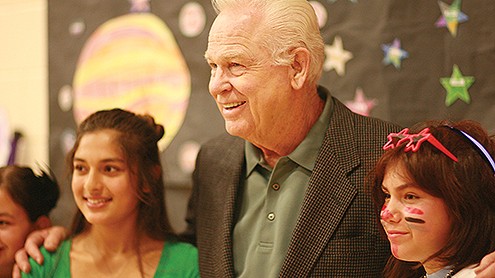
Real estate developer Cal Johnston, center, is the founding chairman of the Boys & Girls Club of Conejo Valley, which works with more than 3,000 kids in the area. (courtesy photo)
The Boys & Girls Clubs of Greater Conejo Valley will honor Cal Johnston, an orphan turned successful Southern California commercial real estate developer, with a building dedication later this month that recognizes his vision in setting up after-school programs for at-risk kids.
Johnston, chairman and founder of The Johnston Group in Agoura Hills, started the first Boys & Girls Clubs in the the Conejo Valley 12 years ago after seeing a dearth of activities for school children.
Boys & Girls Clubs are part of a national organization that has about 4,000 clubs around the country that offer one-on-one mentoring and after-school activities to at-risk youth. “We have six [clubs] in our area that would not be here without Cal Johnston’s vision,” said Mark Elswick, president and CEO of the Boys & Girls Clubs of Greater Conejo Valley.
Those six clubs work with more than 3,000 children in the Conejo Valley and Calabasas. All are on middle-school campuses — an innovative model that Johnston pioneered.
Johnston and his wife, Marje, are actively involved with the Boys & Girls Clubs to this day, offering hours of fundraising and planning assistance as well as direct monetary support. They have given about $3 million out of pocket to the group, Elswick said. “Without Cal and Marje, this organization would never have gotten off the ground.”
Johnston said youth causes were a natural for him. “I was brought up in an orphanage myself after my parents passed away when I was about 4 years old,” Johnston said. “I think this is a way for me to give back.”
Although he was parentless, Johnston said there were adult mentors who reached out to him and pointed him in the right direction. That, he said, made all the difference. “I felt that was a very important thing – I had mentors who were helping to make me independent. I think that if you can do that for young kids, they can develop a lot better and have a much better future.”
After attending the University of Southern California, Johnston became a prolific real estate developer.
He founded The Johnston Group in 1959, two years after building his first Southern California development. In the early ’60s, he formed Property Research Corp., which charted the routes of new freeways, studied population growth and conducted research on demographics and future trends in fast-growing California. He and his clients snapped up thousands of acres of land and pushed them through the planning and development process, according to a company biography.
In the late 1960s, Property Research Corp. organized and registered various security offerings including Six Flags Over Georgia and Six Flags Over Texas. The firm sold these properties in the late 1990s to Time Warner for $275 million and $325 million, respectively.
By the ‘70s, Johnston had formed an apartment development firm that went on to build out about 3,000 units in the Western U.S. In 1985, he founded the Technology Corridor Association to promote clean business and industry along the corridor from Woodland Hills to Thousand Oaks. Over the next two decades, his company developed business parks and its current holdings include the Westlake Corporate Centre in Westlake Village and Thousand Oaks Corporate Plaza in Thousand Oaks.
Johnston’s involvement with the Boys and Girls Clubs also includes as a trustee for the national organization, a role in which he was able to travel to clubs around the country to study their models. When he returned to the region as founding chairman of the Conejo Valley organization, he decided to implement a new model for the clubs. Rather than having Boys & Girls Clubs housed far away from schools and having students be transported to those locations, Johnston set up building partnerships to build on-campus clubs.
“We didn’t have any Boys & Girls Clubs in our area, and we were having more and more issues with the middle school children not having a place to go after school,” Johnston said. “That leads to potential issues of getting in to things they probably shouldn’t be involved with.”
Johnston wanted the clubs to have their own presence with room to grow. He organized partnerships with the Conejo Valley Unified School District and the city of Thousand Oaks to secure land use for before and after school programs and activities and was hands-on with the development of the ground-up buildings.
“Building clubs is somewhat like building commercial buildings,” he said. “There’s a lot of issues involved, like utilities and parking, that have to be solved. We have been able to come up with lease arrangements for locations with the school district. We pay $1 a year to rent the land, and we let the school district use the rooms in the clubs during the school day. There’s not a day that goes by that some of those rooms aren’t being used.”
The Boys & Girls Clubs of Greater Conejo Valley now work with more than 3,000 children in the region at locations in Thousand Oaks, Newbury Park, Westlake Village, Calabasas, Agoura Hills, Oak Park and Hidden Hills.
Elswick said Johnston’s private-sector experience no doubt helped as the real estate developer recognized the important of location in picking a building. The on-campus model means students can go directly to the Boys & Girls Club after school, without having to be bused between locations. That makes participation that much more likely, he said.
Johnston also recognized the need for the clubs to be highly visible, rather than tucked away somewhere in the back of the campus.
Johnston’s wife, Marje, has served as a member of the programs committee, leading the effort to ensure that lower-income families were aware of the programs available to them and having many of the organization’s literature printed in Spanish. She is an active committee member for the group’s annual fundraising events.
Elswick said the Johnstons are humble and for years asked the board not to do something like a building dedication in their name. “Cal has been the one to tell me not to do this, knowing that the naming rights on a building is an asset that can be sold for additional revenue,” he said. “But it was finally time to us to be able to do this to recognize the work that he and Marje have put in.”
It is perhaps Johnston’s leadership style that leaves the biggest impression, though. “He puts a lot of thought and a lot of energy in to what he does. His mind is always turning,” Elswick said. “He just wills it through. If somebody tells him ‘no,’ he’ll just approach the issue in another way. I’ve never seen a more driven person in my entire life, and I have 20 years of nonprofit experience, working with some very driven people.”
The building dedication will take place on Sept. 18 at noon at the future Cal & Marje Johnston Boys & Girls Club, located on the campus of Colina Middle School, 1450 E. Hillcrest Drive in Thousand Oaks.
The Boys & Girls Clubs continue to expand. The Johnstons are already working on developing three additional clubs in the region. The group is also tightening its focus on the so-called STEM curriculums — science, technology, engineering and math — and music and arts, plus after-school nutrition programs combined with sports and exercise.






 Print
Print Email
Email
















